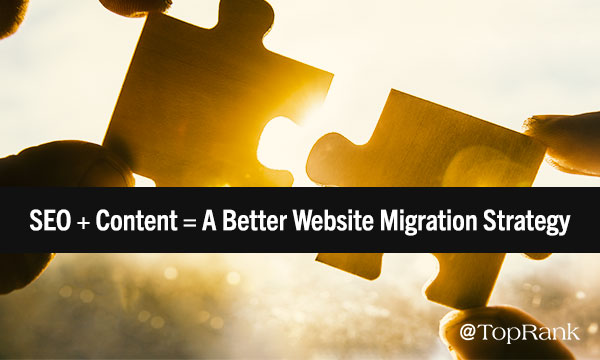
Digital marketers know their company’s website is more than a digital storefront. It’s a marketplace that must deliver a quality, engaging experience for prospects and customers once they arrive. So, it’s no surprise that the average company invests in a website redesign every three years to stay fresh, competitive, and meet evolving customer expectations.
In our experience, however, design faux pas aren’t the biggest marketing missteps that can lead to poor results after a migration—it’s the lack of a solid website migration strategy that encompasses both SEO and content considerations.
There’s no question that SEO needs to play a leading role in the planning, design, and execution of any website migration. But SEO can’t stand alone—it needs a content lens to ensure a solid performance after the switch is flipped.
Better Together: Content + SEO for Migration Success
A poorly planned and executed migration after a site refresh or redesign can lead to decreases in organic traffic and reduced search visibility in both the short- and long-term. And chances are, your marketing team has spent innumerable hours crafting content and optimizing your site for both user experience and search engine performance—and you don’t want it all to be for naught.
By baking content and SEO into your website migration strategy, you have the opportunity to:
#1 – Strike that oh-so-necessary balance between SEO and user experience.
If you’re embarking on a website redesign, chances are your goals are to improve user experience and optimize conversions paths, all while strengthening your organic search footprint. But without SEO and content working together, the steps you take to reach those goals can’t be fully informed or reach their full potential. The key is integration from the start.
For a smooth website migration process, integration of #content & #SEO is key from the start. – @Alexis5484 Click To Tweet
#2 – Bolster top performing content (and weed out weak or irrelevant content).
Site migrations often involve some picking and choosing as far as what content needs to be kept, killed, updated, or created. The last thing you want to do is cut or disrupt the content your audience loves—but you also don’t want to pass up opportunities for adding or improving content with potential or killing content that’s no longer viable. As a result, this is definitely the sweet spot for SEO and content integration in a migration scenario.
From an SEO perspective, you can leverage Google Analytics and Google Search Console to analyze traffic, conversions, ranking, and engagement rates. Then content can be grouped into suggested buckets of what content stays, what content needs updates, what content can be killed, and what content you may be missing. From there, strategic content tweaks can be made with both SEO and user experience in mind before launch.
During a website migration, the last thing you want to do is cut content your audience loves. But you also want to take advantage of opportunities to improve content with potential. – @Alexis5484 Click To Tweet
Read: How to Use Google Search Console to Increase SEO Visibility
#3 – Promote your new and improved site.
After making your shiny new site live, it can be tempting to relax and celebrate. But the work isn’t done. Of course, technical SEO considerations such as 301 redirects, site crawlability, site speed, mobile friendliness, and backlinks need QA and monitoring to ensure your content is working its magic on search engines. You’ll also need to make sure your site map is updated in Google Search Console if any URL structures have changed.
But where does that leave your customers and prospects?
Communicating and promoting the changes you made is a must—but it’s something that is often overlooked. So, in addition to your post-migration SEO checklist, create a promotional plan (e.g. email newsletter update, social media, blog post highlighting key new features, etc.) to ensure you’re getting the word out.
The importance of communication & promotion after a website migration should not be overlooked. – @Alexis5485 Click To Tweet
#4 – Make ongoing tweaks that satisfy user and search engine needs.
After launching your redesigned site, you’ll likely be measuring like crazy to learn where users are dropping off, if you’re losing any traffic to key pages, and if you’re losing conversions from anywhere.
Of course, tweaks will be needed to capitalize on SEO opportunities. But just sprinkling in keywords isn’t the answer. You need context and insight—some of which can be drawn from the competitive content landscape—in order to make strategic content updates that better answer your audience’s questions, as well as send positive signals to search engines.
You need context & insight in order to make strategic content updates that better answer your audience’s questions & send positive signals to search engines. – @Alexis5484 #websitemigration Click To Tweet
Integration = More Successful Migration
There’s little doubt that SEO needs be at the forefront of any website redesign and subsequent migration. But it shouldn’t stand alone. By pairing content and SEO together, you can make more thoughtful and strategic decisions that will help you bolster user experience as well as search visibility.
Looking for more insights and tips on SEO and content integration? Here’s some light reading:
Looking for a website migration partner? Look no further. We can help.

Comments are Closed